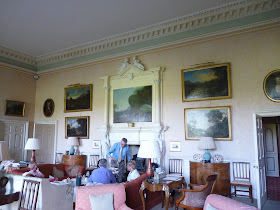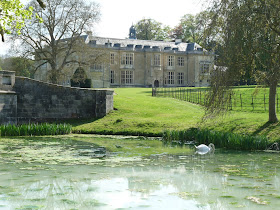On a glorious Bank Holiday Monday off we went to Hartwell
House just outside Aylesbury for a splendid afternoon tea. Firstly though a
tour of the wonderful grounds with their many temples and follies and wonderful
landscape all now threatened by the HS2 Rail Project which will clip the
estate. Then a tour of the house where the brother of the executed Louis XVIII
of France lived in exile with his Court and Queen, Marie-Josephine of Savoy who
died in the house in 1810. Then the denouement, splendid afternoon tea in the
library where in 1814 Louis XVIII signed the Treaty of Paris bringing the Napoleonic
Wars to an end and restoring the House of Bourbon to the Throne of France.
Bourbon Street in Aylesbury is named after them. It is now a very upmarket and
exclusive country house hotel and spa owned by the National Trust.
 |
James Paine’s Kew Bridge of 1783-9 which was
re-erected here in 1901 |
Hartwell House has a remarkable history, stretching back
almost a thousand years to the reign of Edward the Confessor. The property was
first mentioned in the Domesday Book and belonged to an illegitimate son of
William the Conqueror, William Peveral. The lands later belonged to John Earl
of Mortaigne who succeeded his brother Richard the Lion Heart as King of
England in 1199 and Louis XVIII, the exiled King of France who held court there
from 1809 to 1814. Louis was joined at Hartwell by his Queen, Marie-Josephine
de Savoie, his niece the Duchesse D’Angoulême, daughter of Louis XVI and Marie
Antoinette, his brother the Comte d’Artois, later Charles X, and Gustavus IV
the exiled King of Sweden. The arrival
of the impoverished king and his court at Hartwell was not a happy experience
for the mansion, with once grand and imperious courtiers farming chickens and
assorted small livestock on the lead roofs. The King signed the document
accepting the French crown in the library of the house, following the defeat of
Napoleon.

 |
| The Gibbs Pavillion |
Others who lived at Hartwell include Richard Hampden
(d.1567), a member of one of England’s most illustrious families who entered
the household of Queen Elizabeth I and rose to the position of ‘Chiefe Clerk of
the Kychen unto the Queen’s Majestie’. Sir Alexander Hampden (d.1627), who
received the singular Honour of being knighted by James I in his own house; Sir
Thomas Lee (d.1690) who took a leading part in the Restoration and was elevated
to the Baronetage by Charles II in 1660; the Rt. Hon. Sir William Lee
(1688-1754) who became Lord Chief Justice and served for a time as Chancellor
of the Exchequer; and the Rt. Hon. Sir George Lee (1700-1758) a close friend
and adviser to Frederick Prince of Wales whose widow he served as Treasurer and
Receiver-General. The Lees were ancestors of General Robert E Lee of American
Civil War fame. Sir William Young, MP
for Buckingham and later Governor of Tobago was a tenant of Hartwell from 1800
to 1808.
 |
| Library |
 |
| Drawing Room |
 |
| The Great Hall |
 |
| Great Hall fireplace designed by James Gibbs |
 |
| Morning Room |
In 1827, Dr John Lee, an astronomer, inherited the house
from the unmarried Revd Sir George Lee and during his ownership, the British
Meteorological Society, now the Royal Meteorological Society was founded in the
library in 1850. Revd. Nicholas Lee inherited the house when his brother, Dr
John, died on 25 February 1866 at Hartwell.
The house remained a private residence until 1938, when, at risk of
demolition, the estate was acquired by the philanthropist Ernest Cook (a
descendant of Thomas Cook who founded the travel company) and the contents sold
off by public auction. The estate passed to the Ernest Cook Trust when it was
founded in 1952.
 |
| St. Mary's Church |
In the 1960s the house became a girls' finishing school,
then it was let in the 1980s to be run as a hotel. The house was converted and
became part of the Historic House Hotels group. Its proximity to the Prime Minister's country house at Chequers means
that it has frequently been the host of international and Government summits
and meetings including hosting
 |
| An exile in the Library |
the Emperor of Japan.
 |
| Hercules in a thoughtful pose |
The Jacobean north front of the house is constructed of
ashlar and has a projecting porch with a bow window above. At each end of this
facade are two flanking canted bays each with a double height oriel window.
Immediately each side of the porch are two large windows of the hall inside.
Hiding the roofscape is a parapet with vases erected in 1740.
 |
| The Egyptian Spring |
Between 1759 and 1761, architect Henry Keene substantially
enlarged and "Georgianised" the house, and built the east front with
its canted bay windows and a central porch in the Tuscan style. Inside, the
great hall has stucco panels, and three reception rooms with rococo
chimneypieces. The 1980s conversion to a hotel was overseen by the architect
Eric Throssell who created a new dining room in the style of Sir John Soane, by
enclosing the former 18th century open arcaded porch. The former semi-circular
galleried entrance vestibule became an inner hall. Throssel was also
responsible for the design and recreation of the cupola crowning the roof.
 |
| The Vestibule |
 |
| Staircase |
The 900 acres (360 ha) of gardens at Hartwell were laid out
by Capability Brown c. 1750. The North Avenue is a grand vista through trees
planted in 1830, sadly today terminated by the ever encroaching town of
Aylesbury. The gardens are reminiscent of nearby Stowe, with statues, an
obelisk and ornamental bridge. The Hartwell Estate currently covers 1,800 acres
(7.3 km2) of farmland surrounding Hartwell House.
The equestrian statue of Frederick Prince of Wales, son of
George II, in front of the house also speaks of the connection with Stowe as
the “set” around the Duke of Buckingham at Stowe were trenchant in promoting
Frederick’s claim to the throne to protect England from the “Great Danger.”
Frederick never became King as he died before his father and historians to this
day are united in not having a clue as to what the “Great Danger” was! Indeed
the only real legacy from Frederick today is the song originating from the poem
"Rule, Britannia" by James Thomson and set to music by Thomas Arne in
1740 in his opera “Alfred.” The opera was designed to advance the German
Hanoverian Frederick’s claim to the throne by setting him in a long line of
English Kingship from King Alfred.
 |
| Frederick, Prince of Wales |
Hartwell's Egyptian Spring is a folly built in 1850 by
Joseph Bonomi the Younger, an Egyptologist. It is an alcove seat on the western
side of Lower Hartwell opposite a small spring. The stone pylon bears the Greek
inscription ΑΡΙΣΤοΝ ΜΕΝ ΥΔΩΡ, translated as "Water is Best” attributed to
Thales. Elsewhere there are temples, pavilions, obelisks, towers and statues
dotted about the grounds adding a touch of wonder to the landscape. The bridge
over the suitably swanned lake comprises the central arch of James Paine’s Kew
Bridge of 1783-9 which was re-erected here in 1901. The octagonal St. Mary’s
Church to the side of Hartwell House was rebuilt in 1753-5 by Henry Keene and
is one of the finest examples of the Gothic Revival style. Sadly neglected during and
after World War II it has now been partially restored to secure its future. In September 2008 the National Trust acquired a long lease
of the house from the Ernest Cook Trust.
 |
Ceiling in Great Hall designed by James Gibbs and executed
by Giusseppe Artari and Giovanni Bagutti depicting
"Genius rewriting History among the ruins of Antiquity." |

The house and grounds were gifted to the
Trust by the directors of Historic House Hotels (HHH). The house continues its
present use as a hotel under the existing HHH management. By any standards this
gift of Hartwell and two other historic houses run as country house hotels was
hugely generous particularly as the business profits go towards the upkeep. The
hotel business is also responsible for the wonderful state of Hartwell and its
grounds today. The architect Eric Throssell’s redesign and reconfiguration of
the house to convert it to a hotel have given the ground floor a flow and sense
of drama which has enhanced the house and has been accomplished with great tact and sensitivity, including redesigning the Vestibule and Dining room in the style of the Architect, Sir John Soane. Hartwell is eye wateringly expensive but
for all that it is good value for lunch or dinner or for afternoon tea where
its special atmosphere makes you feel you are in a place apart. Its Spa complex
has a particularly patrician atmosphere where you expect to be issued with
togas and be served grapes by Sabine women!

 |
| Hartwell Spa complex |
 |
| The swimming pool |
You cannot visit the hotel and its
grounds at the moment without first having a booking or attending a wedding or
function. However it is envisaged that
arrangements will soon be put in place for the gardens and grounds of the hall
to be open to visitors, along with tours of the ground floor rooms. The Hotel
and Spa have preserved this unique house and it is equally special grounds and
setting and that has been a big ask from a business with just over 50 bedrooms
and a spa complex so I have some sympathy with the management’s desire to keep
it exclusive to justify its premium pricing. For now the easiest way to see
this unique gem is to visit for their excellent afternoon tea at £25 a head
which can be booked on their website.
Hartwell House
Hotel, Restaurant and Spa
Oxford Road, Near Aylesbury
Buckinghamshire, HP17 8NR






















No comments:
Post a Comment